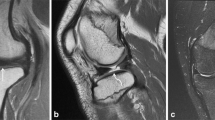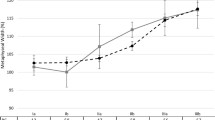Abstract
Objective
The sagging rope sign is a radio-opaque line, seen on radiographs of the hips, with Perthes’ disease. The main purpose of this study was to determine the incidence, cause and importance of this sign in achondroplasia, and to reveal how it differs from in Perthes’ disease.
Design
Serial radiograms, along with 2-dimensional and 3-dimensional CT images were studied in 42 achondroplasic patients.
Patients
Forty-two achondroplasic patients, reported at our institute (for routine outpatient consultation, spine surgeries, deformity corrections, limb-lengthening procedures) were included in this study. There were 26 males and 16 females.
Results
The sign was observed bilaterally, in all patients. Evaluation of CT images revealed spherical heads, with presence of circumferential overhang in all hips. This circumferential overhang, seen on 3-D CT scan, corresponded to the sagging rope sign on radiographs.
Conclusions
Presence of the sagging rope sign in bilateral hips is a characteristic feature of achondroplasia. It usually appears before epiphyseal closure. Its cause, incidence, and nature differ from Perthes’ disease, and its presence does not carry a bad prognosis in achondroplasia.








Similar content being viewed by others
References
Apley AG, Wientroub S. The sagging rope sign in Perthes disease and allied disorders. J Bone Joint Surg Br 1981;63(1):43–47
Clarke NM, Harrison MH, Keret D. The sagging rope sign: a critical appraisal. J Bone Joint Surg Br 1983;65(3):285–287
Kim HT, Eisenhauer E, Wenger DR. The “sagging rope sign” in avascular necrosis in children’s hip diseases –confirmation by 3D CT studies. Iowa Orthop J 1995;15:101–111
Kim HT, Wenger DR. “Functional retroversion” of the femoral head in Legg–Calve–Perthes disease and epiphyseal dysplasia: analysis of head-neck deformity and its effect on limb position using three-dimensional computed tomography. J Pediatr Orthop 1997;17(2):240–246
Herring JA. Skeletal dysplasias: achondroplasia. Tachdjian’s pediatric orthopaedics, vol. 3, 3rd ed. Philadelphia: W. B. Saunders Company; 2002. p 1510–1521
Ponseti IV. Skeletal growth in achondroplasia. J Bone Joint Surg Am 1970;52(4):701–716
Maynard JA, Ippolito EG, Ponseti IV, et al. Histochemistry and ultrastructure of the growth plate in achondroplasia. J Bone Joint Surg Am 1981;63(6):969–979
Bailey JA. Orthopaedic aspects of achondroplasia. J Bone Joint Surg Am 1970;52(7):1285–1301
Stulberg SD, Cooperman DR, Wallensten R. The natural history of Legg–Calve–Perthes’ disease. J Bone Joint Surg Am 1981;63:1095–1108
Author information
Authors and Affiliations
Corresponding author
Additional information
Study conducted at: Department of Paediatric Orthopaedics, Korea University, Guro Hospital, #80, Guro-Gu, Guro-dong, Seoul, Korea
Rights and permissions
About this article
Cite this article
Shingade, V.U., Song, HR., Lee, SH. et al. The sagging rope sign in achondroplasia—different from Perthes’ disease. Skeletal Radiol 35, 923–928 (2006). https://doi.org/10.1007/s00256-006-0166-5
Received:
Accepted:
Published:
Issue Date:
DOI: https://doi.org/10.1007/s00256-006-0166-5




